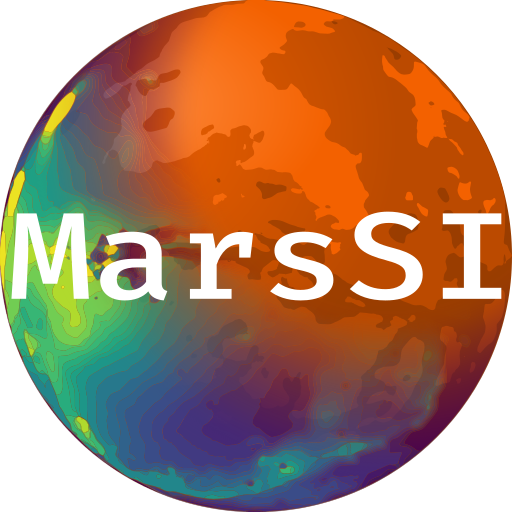1. Connection to MarsSI
The application is opened to the scientific community via the website: emars.univ-lyon1.fr.
A login and a password are required. To create an account, a request has to be made by email to ???. We will create for you both a personal account on MarsSI and an FTP account to retrieve your products. A login and a password will be emailed back to you and they are the same for the access to the MarsSI application and to the ftp account.
figure*
2. MarsSI homepage
There are 3 tabs corresponding to 3 environments:
- the “Maps” tab for data visualization and selection
- the “Workspace” tab for data processing
- the “About” tab to have more information about the application and the products
figure*
2.1. Maps tabs
The “Maps tab” is composed of four windows: “Layers”, “Map tools”, “Map”, and “Cart”. It will help you to select the observation you desire and add them to your cart for further processing.
figure*
In the “Layers” window, you can manage all the available layers to be displayed in the “Map” window. The first layer corresponds to the Mars Orbiter Laser Altimeter (MOLA) global map (topography) and the second one to the THermal EMIssion Spectrometer (THEMIS) day infrared global map. The “eye” icon enables to display the layer in the “Map” window. The next layers correspond to the image footprints for each available instrument from different missions including Mars Reconnaissance Orbiter (MRO), Mars Express (MEx) and Mars Odyssey (MO). See the Section IV to have details about the data types.
In the “Map” tool, you can manage the maps. You can zoom-in using a rectangular feature or by clicking on an area on the “Map” window and and zoom-out. You can also get information about the selected images by using the “Show features” button. If you want to select an observation for your cart, you have to use the “Select” button and click on the desired observation or click and drag on a group of observations. If you want to search through observations based on geographic information or attributes click on “Search”. You have different options. The first option is by geographic information. You can draw an area using a point, line or polygon or you can zoom-in the current selection. The second option is by attributes. Select the type of layers/observations, an attribute which can be the target name, the id, the latitude, the longitude, the geometric angles etc., then theoperator “contains”,“equal to” or “not equal to” and finally the value. You can add several attributes by clicking on the plus button. To process one or several images, you have to add them into the “Cart” window by selecting the observation and clicking on the “Add” button. You can remove one or several observation(s) just by clicking on it in the “Cart” window and on the “Remove” button.
